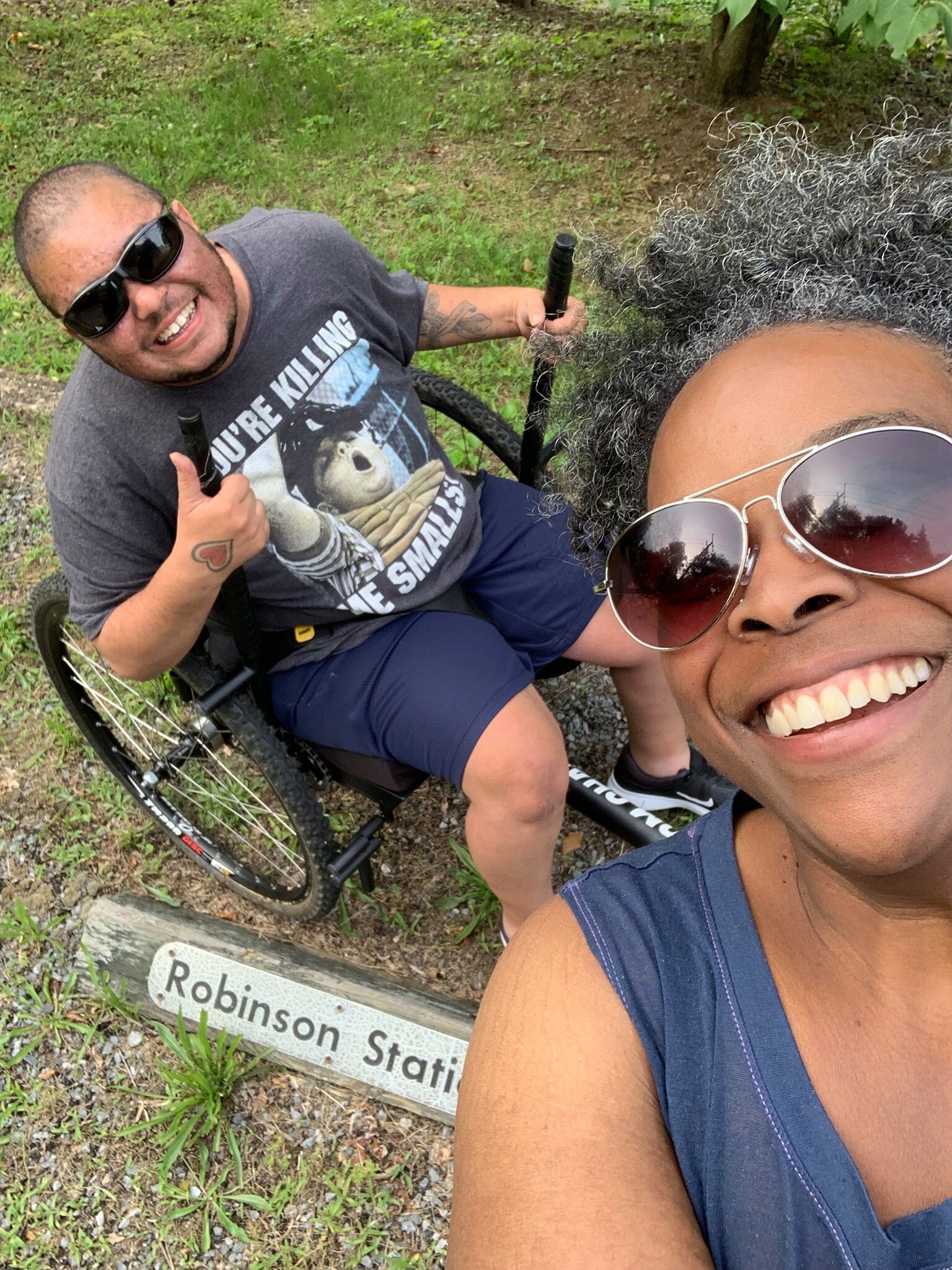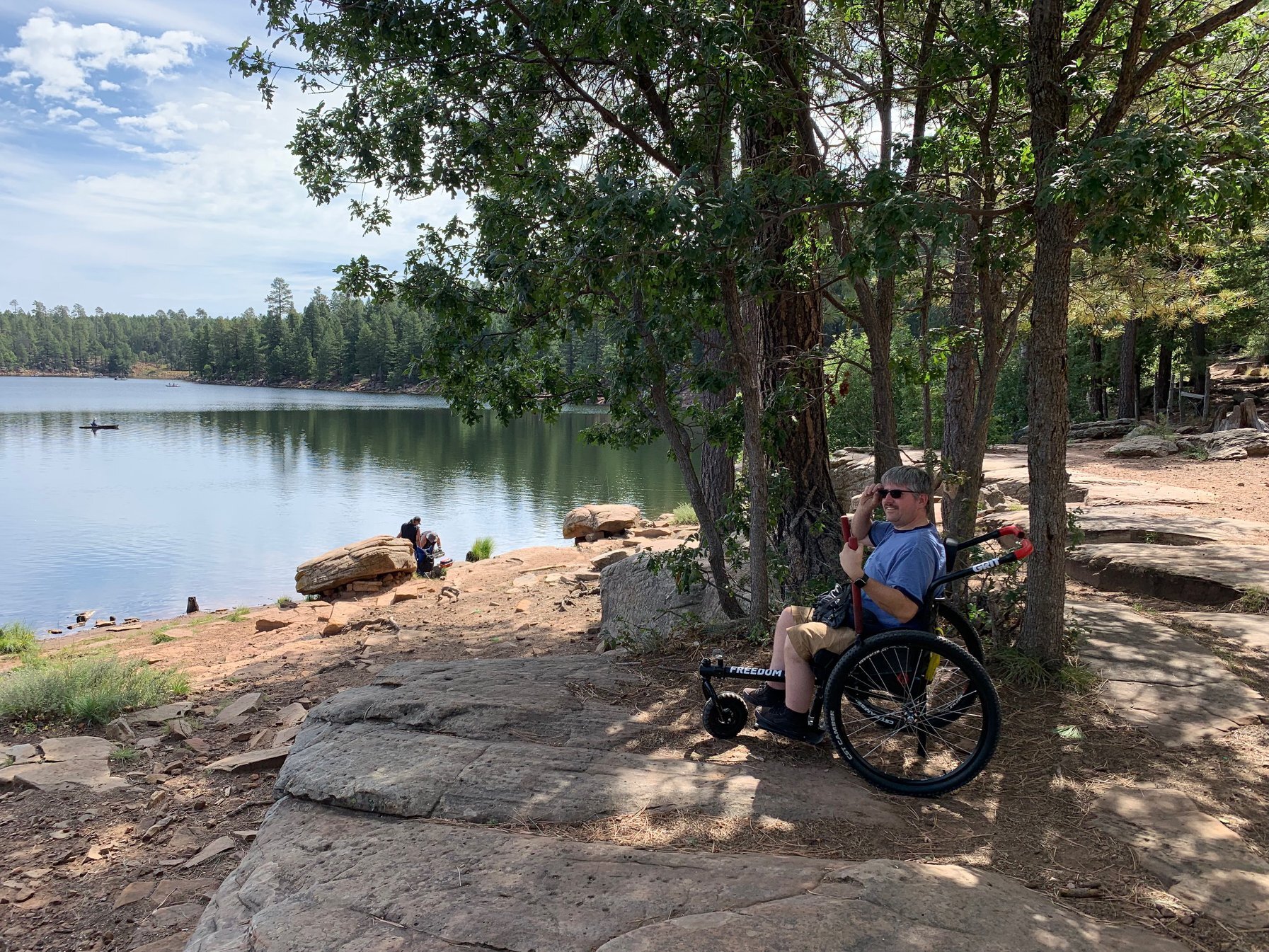As you prepare to head to the trailhead, make sure you’re setting yourself up for success by avoiding these common mistakes. There are thousands of adventures out there waiting for us all. With a little foresight, a bit of research, some good conversation, and the right expectations, you’ll find yourself better prepared than most.
Mistake #1: Not preparing for the weather ahead.
Weather, here, is a catch-all scapegoat for changes in temperature, for changes in humidity, for unexpected bouts of heat and sun and rain and snow, and, well, whatever else nature decides to throw at you when you’re on the trail. As author Alfred Wainwright famously said, “There’s no such thing as bad weather, only unsuitable clothing.” When it comes to adaptive hiking, we couldn’t agree more.
Check the forecast. Check it again. Remember that temperature and humidity fluctuate with elevation change. Consider the fact that, when you’re working your butt off on a really tough hike, you’re probably going to want to shed some layers. And then remember that when you’re cresting over the tree line on the same hike, the wind will likely make you want to re-add a layer or two. Even shorter hikes can merit a backpack with some extra clothing.
Not sure what to bring? Ask the group at Beyond the Pavement, a Facebook group dedicated to outdoor, adaptive recreation. That group is a virtual playground for active folks, so ask for their suggestions!
Mistake #2: Not being on the same “support page” as your fellow hikers.
If there were ever to be a distinction between hiking and adaptive hiking, it would come down to the kind of support a hiker may want. This support can come from equipment, or the approach to a hike, or from a friend or family member. At the end of the day, though, all hikers—adaptive or able-bodied or somewhere in between—are out there, following the same kinds of trail markers, the same kinds of cairns, and the same kind of fresh-air-all-around-us escape that brings us to trailheads in the first place.
A hiker using a wheelchair, or hand crutches, or navigating a trail with a sensory impairment, may require a different kind of support than an able-bodied hiker (though to be clear, everyone needs some kind support). Well-intentioned able-bodied people sometimes assume supporting an adaptive hiker means carrying them on their shoulders or pushing them 100% of the way. That’s not always what a hiker wants, and is often the exact opposite of what support should look like. Sometimes, a hiker wants to crush the trail without any able-bodied help. Other times, they may want periodic assistance…when they ask for it. All of these scenarios are possible, and each is 100% okay, but a conversation about support needs to happen so everyone can have a great time.

This conversation has to be fluid, open, and honest. Too much support can rob someone of the whole experience; too little support may unfairly burden one individual and prevent them from completing the goal they set out to complete.
Accepting and offering support can be tremendously difficult. No matter who we are, or what our story may be, every person has a million good reasons to take pride in their independence. When group hiking, everyone needs to respect that.
Sometimes the only “support” someone wants or needs is the physical and emotional space to conquer an obstacle (or trail, or incline, or switchback) independently—to do it without the extra push or lift—and that needs to be allowed. The most important thing here, again, is communication. Talk to the hikers around you, speak candidly to the friends and family members adventuring alongside you, and give everyone permission to listen to their own voice, too. Able-bodied helpers need to respect how much support a hiker wants (or doesn’t want) at every moment, and the only way to make it to the destination together is to openly and honestly communicate the whole time.

Bonus: Click here to watch “From My Window,” a short documentary about Melissa Simpson, GRIT Freedom Chair rider. She has hiked with teams as small as two and as large as 20+!Mistake #3: Not bringing appropriate supplies and equipment.
Translation: Do everything you can to prevent your equipment from being the reason you have to turn back home. Part of that means selecting the right equipment from the start (i.e., wear the right clothing—check out REI’s tips, here), but it also means coming prepared for possible repairs, patches, trail-mix breaks, hydration opportunities, and other unexpected moments.
Of course, you don’t need to bring a seven-day pack and 48 gallons of water for your post-dinner hike through the local park. But, an extra tube for your pneumatic wheelchair wheel? A flashlight? A granola bar, in case you want to push out another mile before returning home? Yup!
If you’re using mobility equipment, bring a reasonable amount of spare parts and tools. The manufacturer of that equipment will be able to recommend the tools you should bring (we put ours on our Support Center). It’s always better to bring more than you need than to need more than you’ve brought, so pack up that backpack, load up your trail bag, and ride out with some well-earned peace of mind.
Mistake #4: Not knowing enough about the hike ahead of time.
This can be a big one, and while there aren’t always volumes of information about every trail you go on, there are resources that can make the search for the perfect trail a bit easier.
Some questions folks often forget to ask: Are there bathrooms at the parking lot? Are those bathrooms accessible? What does accessible really mean here? What kinds of terrains should I expect—gravel, mud, sand, grass, narrow switchbacks, steep inclines?
Jennifer Wilde, Director of Outreach and Development for Adventures Without Limits, which runs an awesome adaptive hiking program (and so much more), says, “When you’re looking to get to the river, or the lake, or wherever you’re going, there isn’t often a paved pathway or a launch or ramp that’s perfectly accessible.” Before you head out, run a few internet searches on your intended destination. See what notes are available from other local organizations (like this one, all about accessible trails in Massachusetts). Ask your friends and local hiking groups to see if they have any information to add.
Move United, which aims “to provide national leadership and opportunities for individuals with disabilities to develop independence, confidence, and fitness,” is a terrific resource. Check out their hiking page here, which includes links to trails, equipment tips, and ways to connect with other adaptive hikers.
Mistake #5: Not pursuing your own summit.
If you roll into the weight room and try to bench press as much as the biggest, stoutest Incredible-Hulk-of-a-human in the room, it’s probably not going to go so well. Adaptive hiking is no different. There are hundreds of thousands of adaptive hikers around the world, all of whom are pursuing the same goals (i.e., the same stimuli) as you, but are doing so in very different ways. If you’re looking to push your boundaries—to hike longer, or farther, or higher than you’ve ever gone before—well, heck yes, go for it! But, it is also important to recognize the value of realistic goals and of giving yourself the chance to work toward them.
Working toward your goals, also, looks different for every single hiker—both in destination and in method—so don’t compare your achievements with those of others. If you are hiking, you are hiking, and that’s a darn-awesome thing. Whether you’re going ¼ mile into the woods or on a three-day woodsy adventure, you’re doing it right.
We think Jennifer Wilde, who we mentioned above, says it best when she says, “In all of our programs, we celebrate success—locally and individually—a lot of times the success is just trying something new and pushing yourself, and it’s not necessarily about crushing this many miles, or this class of river—it’s about just getting out there and having a positive experience with nature.”

Now, get out there!
Do your research, prepare for the trail ahead, check the weather, and set yourself and your fellow hikers up with the same expectations, and go have some fun!

